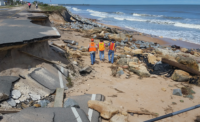The Obama administration has issued tougher risk-management standards for federal agencies to use in determining where federally funded buildings, highways and other infrastructure projects in floodplains should be situated.
The new requirements, contained in an executive order that President Obama signed on Jan. 30, drew praise from state floodplain officials and environmental advocates, but also sparked criticism from a construction group and some lawmakers— including eight Republican U.S. Senators, who question the standard's legality.
John Podesta, counselor to the President, and Federal Emergency Management Agency Administrator Craig Fugate said in a blog post, "This new resilience standard will help ensure taxpayer dollars are well spent on infrastructure that can better withstand the impacts of flooding."
The presidential directive gives agencies three choices for setting appropriate elevation levels for project siting, design and construction:
--Build two feet above the 100-year flood elevations for "noncritical" projects, and three feet above the 100-year mark for “critical” facilities, such as hospitals and evacuation centers
--Build to the 500-year flood elevation
--Use information and methods that draw on “best-available, actionable climate science
A 100-year flood has a 1% annual chance of occurring; for a 500-year event, the chances are 0.2%.
An administration official says that the new standard will apply to federally funded new construction or for "significant" repairs or renovations to make a structure more resilient. The official adds, "Most public progrms consider repairs or improvements to be 'significant' when they cost 50% or more of the fair-market value of the overall project, structure or facility."
Flood-related damage in the U.S. has been severe, totaling more than $260 billion between 1980 and 2013, according to the White House. Hurricane Sandy, which battered New Jersey, New York and other eastern states in October 2012, caused an estimated $67 billion in damages.
The latest National Climate Assessment, released in May 2014, said that more than $1 trillion in property and physical structures could be flooded if the sea level rises by two feet, a mark that could be reached as soon as 2050.
The White House also noted that some 350 cities plus the states of Indiana, Montana and New York already have put their own flood standards in place that equal or exceed the new federal requirements.
Podesta and Fugate noted that the new directive doesn't change flood standards for levees or National Flood Insurance Program rates.
FEMA on Feb. 5 published in the Federal Register draft guidelines ito implement the flood standard. The agency is taking public comments on them until April 6.
Another administration official notes that agencies won't begin to carry out the new standards until after they receive and anayze the public comments on the implementing guidelines and make them final. Thus, the exact date on which the new guidelines will apply to projects has not been determined yet.
Chad Berginnis, Association of State Floodplain Managers executive director, said, “The changing nature of flood risk, including increased risks due to sea-level rise, demands competent standards that will withstand the test of time and the forces of nature. And we think the [new standard] is a great step in the right direction.”
The new resilience yardstick also won praise in environmental circles. Rob Moore, Natural Resources Defense Council senior policy analyst, said in a Feb. 4 blog post that the new standard is “a big improvement,” adding that it “will not only bolster our protections against flooding in the near term, but also will encourage agencies to assess future flood risk, particularly how flood risk may increase in response to climate change.”
But the National Association of Home Builders criticized the White House plan. NAHB said in a Feb. 3 blog post, “This unwarranted expansion will disrupt the constructive efforts that are already underway, introduce new and untested methodologies and only lead to increased inconsistency, confusion and uncertainty.”
Louisiana’s U.S. Senators, Republicans David Vitter and Bill Cassidy, slammed the plan. In a letter Vitter and Cassidy sent to President Obama on Jan. 26, they referred to the then-not-yet-announced action as “another ‘give’ to your far-left environmental base.”
Eight GOP U.S. Senators, including Appropriations Committee Chairman Thad Cochran (Miss.), Vitter and Cassidy, are questioning the legality of the standards, noting that the 2015 omnibus spending law requires the administration to seek and consider input from governors, mayors and other interested parties before the benchmarks can be implemented.
In a Feb. 5 letter to Obama, they asked for detailed information regarding public input received in formulating the standards and any cost-benefit analysis that was done on them.
The Senators said, "We continue to express serious concern regarding the vast implications the issuance of a new [standard] would have on families and workers in communities along the coasts and inland waterways."
An administration official responds that those working on the standard did gather input from stakeholders, "including from state, local and tribal leaders, technical experts and others." The official adds that there will be public meetings and a 60-day comment period before the standard will be implemented.
Sandra Knight and Ed Link of the University of Maryland's Center for Disaster Resilience, College Park, Md., said in a statement that the executive order is "a positive step forward in reducing flood risk and protecting federal investments” by codifying, for federal investments, similar actions taken by federal, state and local governments during the post-Sandy recovery.
But Knight and Link, both senior research engineers at the university, also said that neither the new standards, nor the old one, can really be described as a “risk standard” because the options center around the hazard and do not consider what is vulnerable in a given location.
A flood in an unimproved lowland, for example, carries far less risk than a flood in a dense residential neighborhood, yet under the order, the same standard would apply to both, they note.
"To move forward, we need to objectively and thoroughly consider a risk management standard that is not just dependent on the hazard, but that also can be applied with consistency across federal programs,” Knight and Link said.
In a related development, the Army Corps of Engineers on Jan. 28 released a congressionally mandated study of flood vulnerabilities in the Sandy-affected Atlantic coastal area. http://www.nad.usace.army.mil/compstudy
The two-year Corps study, required by a January 2013 post-Sandy reconstruction spending measure, includes several “opportunities” for further action. They include developing a national coastal storm-risk-management strategy; greater coordination among all levels of government; new local financial incentives for resiliency; and using public-private partnerships in local financing plans for coastal improvements.
The report also states that localities should use a mix of nonstructural and structural flood-risk-management actions.
In addition, the study identified nine “high-risk” areas on the North Atlantic Coast that merit more flood-risk study: the Rhode Island coastline: Connecticut coastline; New York-New Jersey harbor and tributaries; Nassau Co., N.Y., back bays; New Jersey back bays; Delaware inland bays and Delaware Bay coast; Baltimore; the District of Columbia; and Norfolk, Va.
Story updated on Feb. 6 with further administration comment, letter from Republican Senators.
Two quotes corrected on Feb. 10.





Post a comment to this article
Report Abusive Comment